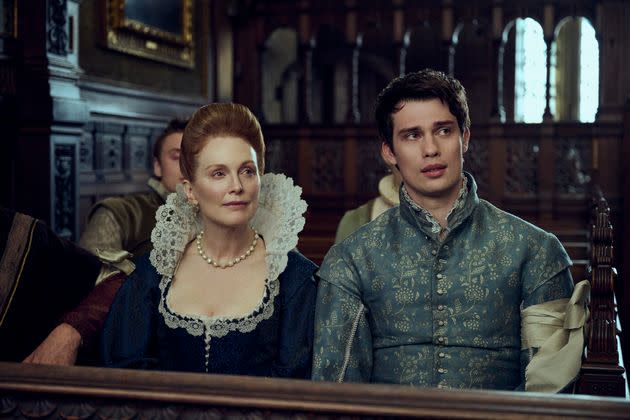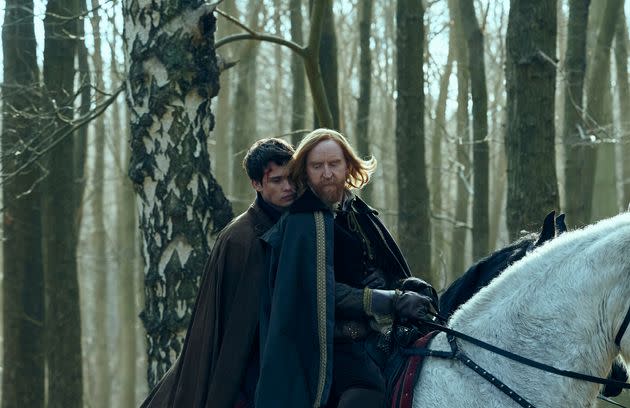'Mary & George' Lets Us Reimagine All History As Queer History
- Oops!Something went wrong.Please try again later.
- Oops!Something went wrong.Please try again later.

“Mary&George” — a new drama streaming on Starz that charts the fantastic rags-to-riches rise of George and Mary Villiers, the first Duke and Countess of Buckingham, in King James I’s 17th century England — is a bodice-ripper with a twist: Everyone is queer.
OK, not every single person in the cast — but there are enough twinks and soft-butch eye candy to constitute a televisual queer community whose members are living their sexiest, most flamboyant gay lives in the Jacobean court scene. It’s like a gay, far-throwback “Gossip Girl” with more etiquette and orgy scenes.
What makes this kinky, corseted brand of representation different from, say, “Gentleman Jack” or any number of contemporary-set queer or queerish shows? It’s the community. It’s not just that “Mary & George” normalizes the notion of sexually fluid queer community — it historicizes it. And that does a specific kind of psychological work for both queer individuals and for queerness as a concept.
“Mary & George” obviously isn’t alone in excavating queer history from the bowels of the cis-het archives and seeking to show a world in which queerness is yassified. But if “Schitt’s Creek” invited us to imagine a world without homophobia, then “Mary & George” ups the ante by begging us to wonder, “What if everyone was kind of gay?” You know, like the way the world actually is — or the way that many queers experience the world as a queer bubble that floats in the sea of the status quo.
I, for example, am aware that white cis-heteronormativity is the norm, but most of the people I interact with on the daily are other queerdos. Still, I assumed that the idea of living in a queer bubble was new, or at least modern. Of course I know that queer people have always existed, but I thought that they were forever lurking in the shadows of secrecy. It never occurred to me that queers throughout the whole of history created close social networks that supported them, nurtured them and constituted the fabric of their everyday lives.
If I’m being honest, I thought of queer history as half communitywide struggle and half discrete, individual joy.“Mary & George” turned that idea around for me. Somehow, my community’s joys and struggles feel more real by watching these satin-bedecked queers help each other make their way in the royal world. Queer community is not a response to the contemporary world; it’s a long-standing queer tradition. So, was my flawed assumption a product of internalized homophobia? Perhaps in part, but it could be more complex than that.

“One of the ways that marginalized people are harmed is to be dismissive of their identities and pathologize them by saying they’re reacting to a trend, and they’re not really who they say they are,” says Dulcinea Pitagora, a queer psychotherapist based in New York City who works with people with marginalized sexual and gender identities. “This is another form of erasure, a reminder that humans have always been fluid in terms of gender, sexuality and relationships.”
And we have always banded together, not just to fight or fuck. The queer community isn’t some new, fragile invention that could be dismantled at any moment. I, for one, really needed this reminder.
Many online conversations around “Mary & George” question how truth-based the show is, but that doesn’t really matter. We can’t know the past. I don’t really care if Mary Villiers actually had a super hot femme domme who helped her finagle her fey son into British royalty.
What I do care about is being provided a portrayal of people like me hundreds of years ago having the kind of sex that I like to have with the kind of people I like to have sex with — and forming community bonds and alliances regardless of social status. This kind of representation feels deep and personal.
“There is huge psychological value of seeing your community as well as sexual preferences and orientations affirmingly represented in a mainstream context,” Pitagora says. “People in nonmainstream gender, sexuality and relationship communities have been force-fed stigma in the form of nonrepresentation and pathologization. A big component of healing from internalized stigma and shame comes in the form of ‘positive reflected appraisals’ — seeing community members represented in a way that reflects well on the individual.”
Positive reflected appraisal generally comes from within queer community, Pitagora says, but he adds that it’s equally important to see positive reflections in the larger community on a mainstream level — for example, in a highly publicized series on Starz. I can’t speak for all queer people and I certainly can’t speak on behalf of nonqueers, but the fact that “Mary & George” is a major production with big-name stars — Julianne Moore and Nicholas Galitzine, swoon and swoon — seems like a win for queer representation in general.
To be fair, queer people on the show are not always portrayed positively. Mary is a scheming social climber, and George is a passive-aggressive predator. But those flaws are distinct from their sexual identities. As in life, people aren’t assholes because they’re gay; it’s just that some gay people are assholes.
Ultimately, the series shows off queerness to the world in a nuanced way that feels authentic. “Such representation plays a big role in combating stigma, especially given that stigma is reinforced by the opposite phenomenon that’s happening most of the time — the erasure at best and poor portrayal at worst of queer and trans people in mainstream media,” Pitagora says.
Queer people may not be heroic figures in the courtly world of “Mary & George,” but they are layered and lovable in their complexity and in community.
